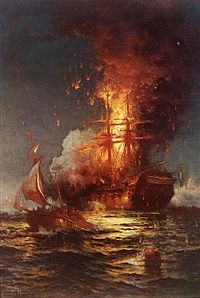- Mediterranean Squadron (United States)
-
Mediterranean Squadron 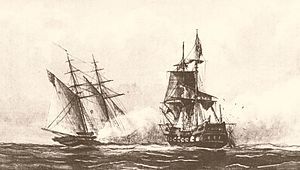
USS Enterprise of the Mediterranean Squadron capturing the Tripoli during the First Barbary War.Active 1801 - 1865 Country  United States
United StatesBranch  United States Navy
United States NavyType Naval squadron - For the navies of other nations in the Mediterranean, see Mediterranean Fleet (disambiguation).
The Mediterranean Squadron, also known as the Mediterranean Station, was part of the United States Navy in the 19th century that operated in the Mediterranean Sea. It was formed in response to the Barbary Wars. Between 1801 and 1818, the squadron was composed of a series of rotating squadrons. Later, squadrons were sent in the 1820s to the 1860s to suppress piracy, primarily in Greece and to engage in gunboat diplomacy.[1] In 1865 the force was renamed the European Squadron.
Contents
History
First Barbary War
Main article: First Barbary WarThe Barbary pirates' seizure of American merchant ships went back to just after the victory over Great Britain in 1783. When the Dey of Algiers demanded tribute, the Americans refused and thus began a long series of conflict between the Barbary states and the United States lasting from the 1780s to 1815. The Mediterranean Squadron was created for the protection of American merchant ships sailing in Mediterranean waters. The first squadron sent was under the command of Commodore Richard Dale. His command included the frigates USS Boston, sloop-of-war USS George Washington and the schooner USS Enterprise. During the squadron's deployment from 1801 to 1802, it operated by convoying merchant ships. Commodore Dale did not have orders to capture enemy vessels and could only respond to the North African's attacks if fired upon first or if coming to the aid of a merchant ship. On August 1, 1801 the twelve gun schooner USS Enterprise under the command of Lieutenant Andrew Sterett encountered the fourteen gun Tripolitan polacca named Tripoli. USS Enterprise captured the Tripoli after a long and bloody fight but because the squadron could not legally make a prize of the ship, it was stripped of its fighting capabilities and released.
As attacks on merchantmen continued, the United States government eventually authorized the United States Navy to send a second squadron to blockade Tripoli and attack their ships. In May 1802 Captain Daniel McNeill in USS Boston assisted two Swedish frigates in a battle while blockading Tripoli. In the action several Barbary vessels sortied and the Americans and Swedish frigates fought off the attack which then forced the Tripolitans back into harbor. In June 1803, USS John Adams and USS Enterprise defeated nine enemy gunboats and a polacre near Tripoli. The polacre was sunk and the gunboats forced to flee, the Americans suffered no casualties. The second squadron returned to the United States in 1803 and that same year another force was sent and operated until 1804. On October 31, 1803, USS Philadelphia grounded on a reef just off Tripoli Harbor. Under heavy fire from enemy shore batteries the Americans attempted to reflot their ship but she was hard aground. When Tripolitan gunboats approached for her capture, her commander surrendered his ship and was made a slave along with the crew. Philadelphia was then manned by the Tripolitans as a sort of harbor defence until February 16, 1804. On that night Lieutenant Stephen Decatur in the ketch USS Intrepid boarded and recaptured the Philadelphia and scuttled her by fire. This was the most remembered action in the battle for Tripoli. Decatur became famous immediately after this and had a long career of serving the American navy with distinction. He later commanded American forces during the Second Barbary War in 1815.
At the final engagement of the war in April and May 1805, the brig USS Argus, the schooner USS Nautilus and the sloop USS Hornet provided gun support for ten American marines and soldiers leading a mercenary army against Derne. During the battle the Mediterranean Squadron vessels under Oliver Hazard Perry bombarded the city while the land forces besieged the Tripolitan garrison. When the city finally fell, the Dey of Algiers surrendered and the First Barbary War was over.
Second Barbary War
Main article: Second Barbary WarThe Mediterranean Squadron continued to operate until 1807. That year the squadron was withdrawn which tempted the Barbary corsairs to attack American ships again. It was not until the end of the War of 1812 in 1815 that the United States Navy resumed operations against the Barbary coast. Now a commodore, Stephen Decatur led the main squadron of ten vessels including the frigates USS Guerriere, USS Macedonian, USS Constellation, the sloops USS Epervier and USS Ontario, the brigs William Bainbridge included the ship of the line USS Independence, the frigates USS Congress, USS Java and USS United States with eight smaller vessels but these warships did not see combat. Only two battles were fough during the Second Barbary War. Decaturs squadron captured the Algerian flagship Mashouda of forty-six guns off Cape Gata on June 15 and later defeated the twenty-two gun Estedio off Cape Palos on June 19. After, the squadron arrived at Algiers and prepared for battle but before fighting began the enemy surrendered and the short war came to an end.
Anti-piracy operations
Main article: Aegean Anti-Piracy CampaignShips of the Squadron
First Squadron
Commanded by Commodore Richard Dale. Deployed in 1801, and returned to the United States in 1802.[1]
Name Type Guns Captain Boston [1] 2nd class frigate 28 guns [1] Daniel McNeill [1] Enterprise [1] Schooner 12 guns [1] Andrew Sterett [1] Essex [1] 2nd class frigate 32 guns [1] William Bainbridge [1] George Washington [1] Sloop of war 24 guns [1] John Shaw [1] Philadelphia [1] 2nd class frigate 36 guns [1] Samuel Barron [1] President [1] 1st class frigate 44 guns [1] James Barron [1] Second Squadron
Commanded by Commodore Richard Valentine Morris,[1] and later Commodore John Rodgers, who took command after Morris's health began to fail.[2] Deployed in 1802, and returned to the United States in 1803.[1]
Name Type Guns Captain Adams [1] 2nd class frigate 28 guns [1] Hugh Campbell [1] Boston [1] 2nd class frigate 28 guns [1] Daniel McNeill [1] Chesapeake [1] 2nd class frigate 36 guns [1] Isaac Chauncey,[1] James Barron [1] Constellation [1] 2nd class frigate 36 guns [1] Alexander Murray [1] Enterprise [1] Schooner 12 guns [1] Andrew Sterett,[1] Isaac Hull [1] George Washington [1] Sloop of war 24 guns [1] John Shaw [1] John Adams [1] 2nd class frigate 28 guns [1] John Rodgers [1] New York [1] 2nd class frigate 36 guns [1] James Barron,[1] Isaac Chauncey [1] Third Squadron
Commanded by Commodore Edward Preble.[1] Deployed in 1803, and returned to the United States in 1804.[1]
Name Type Guns Captain Argus [1] Brig 16 guns [1] Isaac Hull [1] Constitution [1] 1st class frigate 44 guns [1] John Dent,[1] Thomas Robinson [1] (Lieutenants acting as flag captain to Commodore Preble) [1]
Enterprise [1] Schooner 12 guns [1] Stephen Decatur [1] Intrepid [1] Ketch 4 guns [1] Stephen Decatur,[1] Richard Somers [2] John Adams [1] 2nd class frigate 28 guns [1] Isaac Chauncey [1] Nautilus [1] Schooner 12 guns [1] Richard Somers,[1] John Dent [1] Philadelphia [1] 2nd class frigate 36 guns [1] William Bainbridge [1] Scourge [1] Brig 16 guns [1] John Dent,[1] Ralph Izard [1] Syren [1] Brig 16 guns [1] Charles Stewart [1] Vixen [1] Schooner 12 guns [1] John Smith [1] In 1843, the squadron comprised four ships, Columbia, Cumberland, Fairfield and Plymouth.
Commanders
Name Picture Rank Assigned
(Orders)Assumed
(On Station)Relieved
(Orders)Relieved
(On Station)1 COM Richard Dale [3]
(First Squadron) [2]

May 20, 1801 [2] July 1, 1801 [4] ? ? 2 COM Richard Morris [3]
(Second Squadron) [2]

? May 25, 1802 [5] June 21, 1803 [2] September 11, 1803 [2] 3 COM John Rodgers [5]
(Second Squadron) [2]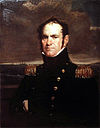

June 21, 1803 [2] September 11, 1803 [5] ? ? 4 COM Edward Preble [3]
(Third Squadron) [2]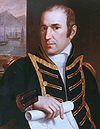

May 19, 1803 [3] September, 1803 [4] 1804 [3] ? 5 COM Samuel Barron [2]
(Fourth Squadron) [2]

April, 1804 [5] September 10, 1804 [5] May 22, 1805 [5] May 24, 1805 [5] 6 COM John Rodgers [5]
(Fourth Squadron) [5]

May 22, 1805 [5] May 24, 1805 [5] ? May 27, 1806 [5] 7 COM Hugh Campbell [5]
(Fourth Squadron) [5]

? May 27, 1806 [5] ? ? COM Stephen Decatur [5] 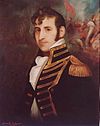

? June 14, 1815 [6] 1815 [6] 1815 [6] COM William Bainbridge [6] 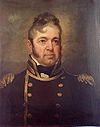

1815 [6] ? ? 6 oct 1815 [7] COM John Shaw [6]

? 6 oct 1815 [7] ? ? COM Isaac Chauncey 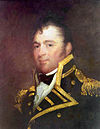

? 1816 [8] ? February 1, 1818 [9] COM Charles Stewart [9] 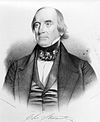

? February 1, 1818 [9] ? 1820 COM William Bainbridge [6] 

? ? ? June 4, 1821 [7] COM Jacob Jones [7] 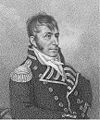

? June 4, 1821 [7] ? 1823 [10] COM John Creigton [5] 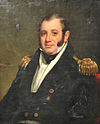

? ? ? 1824 [11] COM Thomas MacDonough [5] 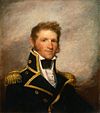

? Nov 24, 1824 [11] ? Apr 30, 1825 [11] COM John Rodgers [5] 

? April 30, 1825 [5] ? May 31, 1827 [5] COM William Crane [12]

? 1827 [12] ? ? - Daniel Patterson 1832-1836
- Jesse D. Elliott 1836-1838
- Isaac Hull 1838-1841
- Joseph Smith 1843
- William Bolton 1848
- Charles W. Morgan 1850
- Samuel Livingston Breese 1856-1859
- Uriah Phillips Levy 1860
References
- ^ a b c d e f g h i j k l m n o p q r s t u v w x y z aa ab ac ad ae af ag ah ai aj ak al am an ao ap aq ar as at au av aw ax ay az ba bb bc bd be bf bg bh bi bj bk bl bm bn bo bp bq br bs bt bu bv bw bx by bz ca cb cc cd ce cf cg Martin, Tyrone G. (1905). Our Navy and the Barbary Corsairs. Chester: Houghton Mifflin.
- ^ a b c d e f g h i j k l McKee, Christopher (1996). Edward Preble: A Naval Biography. Naval Institute Press. ISBN 978-1557505835.
- ^ a b c d e Martin, Tyrone G. (1980). A Most Fortunate Ship: A Narrative History of "Old Ironsides". Chester: Globe Peqout Press. ISBN 0871060337. OCLC 6707539.
- ^ a b Symonds, Craig L.; Clipson, William J. (2001). Naval Institute Historical Atlas of the U.S. Navy. Naval Institute Press. ISBN 978-1557509840.
- ^ a b c d e f g h i j k l m n o p q r s t u Charles, Charles Oscar (1910). Commodore John Rodgers, Captain, Commodore, and Senior Officer of the American Navy, 1773-1838. The Arthur H. Clark Company.
- ^ a b c d e f g Waldo, S. Putnam (1822). The Life and Character of Stephen Decatur; Late Commodore and Post-Captain in the Navy of the United States, and Navy-Commissioner. Clarke & Lyman.
- ^ a b c d e Harris, Thomas (1837). The Life and Services of Commodore William Bainbridge, United States Navy. Carey Lee & Blanchard.
- ^ United States Navy Historical Center. "US People--Chauncey, Isaac, Commodore, USN". http://www.ibiblio.org/hyperwar/OnlineLibrary/photos/pers-us/uspers-c/i-chaunc.htm. Retrieved 9 March 2010.
- ^ a b c This article includes text from the public domain Dictionary of American Naval Fighting Ships.
- ^ United States Navy Historical Center. "US People--Jones, Jacob (1768-1850)". http://www.history.navy.mil/photos/pers-us/uspers-j/ja-jones.htm. Retrieved 9 March 2010.
- ^ a b c MacDonough, Rodney (1909). Life of Commodore Thomas MacDonough, United States Navy. The Fort Hill Press.
- ^ a b Ripley, George; Dana, Charles A. (1869). New American Cyclopaedia. D. Appleton and Company.
Further reading
- London, Joshua E.Victory in Tripoli: How America's War with the Barbary Pirates Established the U.S. Navy and Shaped a Nation New Jersey: John Wiley & Sons, Inc., 2005.
19th Century Mediterranean Squadron • Chesapeake Bay Flotilla • Mosquito Fleet • North Atlantic Squadron • New Orleans Squadron • Pacific Squadron • West Indies Squadron • Brazil Squadron • East India Squadron • Home Squadron • Africa Squadron
Civil War Atlantic Blockading Squadron • Potomac Flotilla • Mississippi River Squadron
Post-Civil War European Squadron • Asiatic Squadron • Bering Sea Squadron • Flying Squadron • Special Service Squadron
Categories:- United States Navy ship squadrons
- Barbary Wars
Wikimedia Foundation. 2010.

